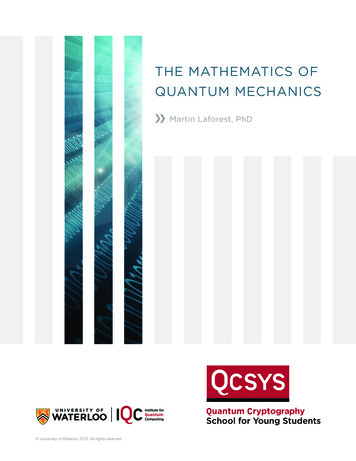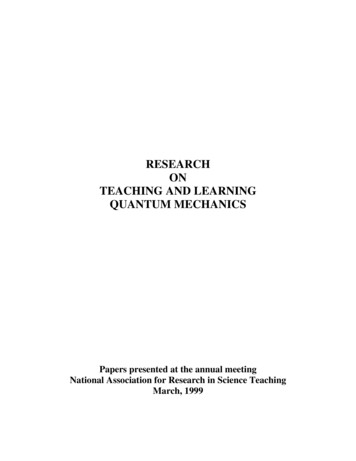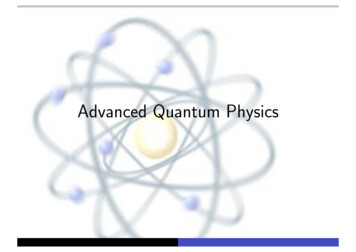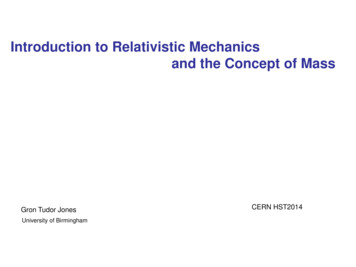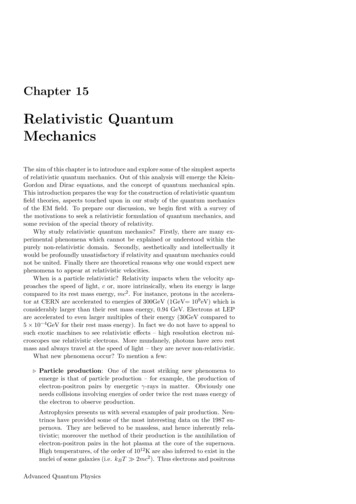
Transcription
Chapter 15Relativistic QuantumMechanicsThe aim of this chapter is to introduce and explore some of the simplest aspectsof relativistic quantum mechanics. Out of this analysis will emerge the KleinGordon and Dirac equations, and the concept of quantum mechanical spin.This introduction prepares the way for the construction of relativistic quantumfield theories, aspects touched upon in our study of the quantum mechanicsof the EM field. To prepare our discussion, we begin first with a survey ofthe motivations to seek a relativistic formulation of quantum mechanics, andsome revision of the special theory of relativity.Why study relativistic quantum mechanics? Firstly, there are many experimental phenomena which cannot be explained or understood within thepurely non-relativistic domain. Secondly, aesthetically and intellectually itwould be profoundly unsatisfactory if relativity and quantum mechanics couldnot be united. Finally there are theoretical reasons why one would expect newphenomena to appear at relativistic velocities.When is a particle relativistic? Relativity impacts when the velocity approaches the speed of light, c or, more intrinsically, when its energy is largecompared to its rest mass energy, mc2 . For instance, protons in the accelerator at CERN are accelerated to energies of 300GeV (1GeV 109 eV) which isconsiderably larger than their rest mass energy, 0.94 GeV. Electrons at LEPare accelerated to even larger multiples of their energy (30GeV compared to5 10 4 GeV for their rest mass energy). In fact we do not have to appeal tosuch exotic machines to see relativistic effects – high resolution electron microscopes use relativistic electrons. More mundanely, photons have zero restmass and always travel at the speed of light – they are never non-relativistic.What new phenomena occur? To mention a few:! Particle production: One of the most striking new phenomena toemerge is that of particle production – for example, the production ofelectron-positron pairs by energetic γ-rays in matter. Obviously oneneeds collisions involving energies of order twice the rest mass energy ofthe electron to observe production.Astrophysics presents us with several examples of pair production. Neutrinos have provided some of the most interesting data on the 1987 supernova. They are believed to be massless, and hence inherently relativistic; moreover the method of their production is the annihilation ofelectron-positron pairs in the hot plasma at the core of the supernova.High temperatures, of the order of 1012 K are also inferred to exist in thenuclei of some galaxies (i.e. kB T " 2mc2 ). Thus electrons and positronsAdvanced Quantum Physics
168Figure 15.1: Anderson’s cloud chamber picture of cosmic radiation from 1932 show-ing for the first time the existence of the positron. A cloud chamber contains a gassupersaturated with water vapour (left). In the presence of a charged particle (suchas the positron), the water vapour condenses into droplets – these droplets mark outthe path of the particle. In the picture a charged particle is seen entering from thebottom at high energy. It then looses some of the energy in passing through the 6 mmthick lead plate in the middle. The cloud chamber is placed in a magnetic field andfrom the curvature of the track one can deduce that it is a positively charged particle.From the energy loss in the lead and the length of the tracks after passing though thelead, an upper limit of the mass of the particle can be made. In this case Andersondeduces that the mass is less that two times the mass of the electron. Carl Anderson(right) won the 1936 Nobel Prize for Physics for this discovery. (The cloud chambertrack is taken from C. D. Anderson, The positive electron, Phys. Rev. 43, 491 (1933).are produced in thermal equilibrium like photons in a black-body cavity.Again a relativistic analysis is required.! Vacuum instability: Neglecting relativistic effects, we have shown thatthe binding energy of the innermost electronic state of a nucleus of chargeZ is given by,! 2 "2mZe.E 4π 02!2If such a nucleus is created without electrons around it, a peculiar phenomenon occurs if E 2mc2 . In that case, the total change in energyof producing an electron-positron pair, subsequently binding the electron in the lowest state and letting the positron escape to infinity (itis repelled by the nucleus), is negative. There is an instability! Theattractive electrostatic energy of binding the electron pays the price ofproducing the pair. Nuclei with very high atomic mass spontaneously“screen” themselves by polarising the vacuum via electron-positron production until the they lower their charge below a critical value Zc . Thisimplies that objects with a charge greater than Zc are unobservable dueto screening.! Info. An estimate based on the non-relativistic formula above gives Zc 270. Taking into account relativistic effects, the result is renormalised downwards to 137, while taking into account the finite size of the nucleus one finallyobtains Zc 165. Of course, no such nuclei exist in nature, but they can bemanufactured, fleetingly, in uranium ion collisions where Z 2 92 184.Indeed, the production rate of positrons escaping from the nucleus is seen toincrease dramatically as the total Z of the pair of ions passes 160.! Spin: Finally, while the phenomenon of electron spin has to be graftedAdvanced Quantum Physics
169artificially onto the non-relativistic Schrödinger equation, it emerges naturally from a relativistic treatment of quantum mechanics.When do we expect relativity to intrude into quantum mechanics? According to the uncertainty relation, x p !/2, the length scale at which thekinetic energy is comparable to the rest mass energy is set by the Comptonwavelengthh λc .mcWe may expect relativistic effects to be important if we examine the motionof particles on length scales which are less than λc . Note that for particles ofzero mass, λc ! Thus for photons, and neutrinos, relativity intrudes atany length scale.What is the relativistic analogue of the Schrödinger equation? Non-relativisticquantum mechanics is based on the time-dependent Schrödinger equationĤψ i! t ψ, where the wavefunction ψ contains all information about a givensystem. In particular, ψ(x, t) 2 represents the probability density to observe aparticle at position x and time t. Our aim will be to seek a relativistic versionof this equation which has an analogous form. The first goal, therefore, is tofind the relativistic Hamiltonian. To do so, we first need to revise results fromEinstein’s theory of special relativity: x ! Info. Lorentz Transformations and the Lorentz Group: In the specialtheory of relativity, a coordinate in space-time is specified by a 4-vector. A contravariant 4-vector x (xµ ) (x0 , x1 , x2 , x3 ) (ct, x) is transformed into thecovariant 4-vector xµ gµν xν by the Minkowskii metric 1 1 (gµν ) gµν gνλ δµλ , , 1 1Here, by convention, summation is assumed over repeated indicies. Indeed, summation covention will be assumed throughout this chapter. The scalar product of4-vectors is defined byx · y xµ y µ xµ y ν gµν xµ yµ .The Lorentz group consists of linear Lorentz transformations, Λ, preserving x·y,µi.e. for xµ ) x! Λµν xν , we have the conditiongµν Λµα Λνβ gαβ .(15.1)Specifically, a Lorentz transformation along the x1 direction can be expressed in theform γ γv/cγ γv/c Λµν 1 00 1where γ (1 v 2 /c2 ) 1/2 .1 With this definition, the Lorentz group splits up intofour components. Every Lorentz transformation maps time-like vectors (x2 0) into1Equivalently the Lorentz transformation can be represented in the form010 1BC 1 0C,Λ exp[ωK1 ],[K1 ]µν B@0 0A0 0where ω tanh 1 (v/c) is known as the rapidity, and K1 is the generator of velocitytransformations along the x1 -axis.Advanced Quantum Physics
15.1. KLEIN-GORDON EQUATION170time-like vectors. Time-like vectors can be divided into those pointing forwards intime (x0 0) and those pointing backwards (x0 0). Lorentz transformations donot always map forward time-like vectors into forward time-like vectors; indeed Λdoes so if and only if Λ00 0. Such transformations are called orthochronous.(Since Λµ0 Λµ0 1, (Λ00 )2 (Λj0 )2 1, and so Λ00 0.) Thus the group splitsinto two according to whether Λ00 0 or Λ00 0. Each of these two componentsmay be subdivided into two by considering those Λ for which det Λ 1. Thosetransformations Λ for which det Λ 1 are called proper.Thus the subgroup of the Lorentz group for which det Λ 1 and Λ00 0 iscalled the proper orthochronous Lorentz group, sometimes denoted by L . Itcontains neither the time-reversal nor parity transformation, 111 1 T P (15.2) , .1 11 1We shall call it the Lorentz group for short and specify when we are including T or P .In particular, L , L L L (the orthochronous Lorentz group), L L L (the proper Lorentz group), and L0 L L are subgroups, while L P L ,L T L and L T P L are not.Special relativity requires that theories should be invariant under Lorentz transformations xµ ) Λµν xν , and, more generally, Poincaré transformations xµ Λµν xν aµ . The proper orthochronous Lorentz transformations can be reached continuously from identity.2 Loosely speaking, we can form them by putting togetherinfinitesimal Lorentz transformations Λµν δ µν ω µν , where the elements of ω µν - 1.Applying the identity gαβ Λµα Λµβ gαβ ωαβ ωβα O(ω 2 ), we obtain therelation ωαβ ωβα . ωαβ has six independent components: L is a six-dimensional(Lie) group, i.e. it has six independent generators: three rotations and three boosts.Finally, according to the definition of the 4-vectors, the covariant and contravari , ), µ x µ ant derivative are respectively defined by µ x µ ( 1c t ( 1c t, ). Applying the scalar product to the derivative we obtain the d’Alembertian 22operator (sometimes denoted as !), 2 µ µ c12 t2 .15.1Klein-Gordon equationHistorically, the first attempt to construct a relativistic version of the Schrödingerequation began by applying the familiar quantization rules to the relativisticOskar Benjamin Klein 1894energy-momentum invariant. In non-relativistic quantum mechanics the cor1977A Swedish theorespondence principle dictates that the momentum operator is associated withretical physicist,the spatial gradient, p̂ i! , and the energy operator with the time derivaKlein is creditedforinventingtive, Ê i! t . Since (pµ (E/c, p) transforms like a 4-vector under Lorentzthe idea, parttransformations, the operator p̂µ i! µ is relativistically covariant.of Kaluza-KleinNon-relativistically, the Schrödinger equation is obtained by quantizingtheory, that extradimensions maythe classical Hamiltonian. To obtain a relativistic version of this equation,be physically realone might apply the quantization relation to the dispersion relation obtainedbut curled upand very small, an idea essential tofrom the energy-momentum invariant p2 (E/c)2 p2 (mc)2 , i.e.string theory/M-theory.) 2 4* 2 4,2 2 1/22 2 2 1/2E(p) m c p c i! t ψ m c ! c ψwhere m denotes the rest mass of the particle. However, this proposal posesa dilemma: how can one make sense of the square root of an operator? Interpreting the square root as the Taylor expansion,i! t mc2 ψ 2!2 2!4 ( 2 )2ψ ψ ···2m8m3 c2They are said to form the path component of the identity.Advanced Quantum Physics
15.1. KLEIN-GORDON EQUATION171we find that an infinite number of boundary conditions are required to specifythe time evolution of ψ.3 It is this effective “non-locality” together with theasymmetry (with respect to space and time) that suggests this equation maybe a poor starting point.A second approach, and one which circumvents these difficulties, is to applythe quantization procedure directly to the energy-momentum invariant:)*E 2 p2 c2 m2 c4 , !2 t2 ψ !2 c2 2 m2 c4 ψ.Recast in the Lorentz invariant form of the d’Alembertian operator, we obtainthe Klein-Gordon equation)* 2 kc2 ψ 0 ,(15.3)where kc 2π/λc mc/!. Thus, at the expense of keeping terms of secondorder in the time derivative, we have obtained a local and manifestly covariantequation. However, invariance of ψ under global spatial rotations implies that,if applicable at all, the Klein-Gordon equation is limited to the consideration ofspin-zero particles. Moreover, if ψ is the wavefunction, can ψ 2 be interpretedas a probability density?To associate ψ 2 with the probability density, we can draw intuition fromthe consideration of the non-relativistic Schrödinger equation. Applying the2 2ψ) 0, together with the complex conjugate of thisidentity ψ (i! t ψ !2mequation, we obtain t ψ 2 i! · (ψ ψ ψ ψ ) 0 .2mConservation of probability means that density ρ and current j must satisfythe continuity relation, t ρ · j 0, which states simply that the rate ofdecrease of density in any volume element is equal to the net current flowingout of that element. Thus, for the Schrödinger equation, we can consistently!define ρ ψ 2 , and j i 2m(ψ ψ ψ ψ ).Applied to the Klein-Gordon equation (15.3), the same consideration implies!2 t (ψ t ψ ψ t ψ ) !2 c2 · (ψ ψ ψ ψ ) 0 ,from which we deduce the correspondence,ρ i!(ψ t ψ ψ t ψ ) ,2mc2j i!(ψ ψ ψ ψ ) .2mThe continuity equation associated with the conservation of probability canbe expressed covariantly in the form µ j µ 0 ,(15.4)where j µ (ρc, j) is the 4-current. Thus, the Klein-Gordon density is thetime-like component of a 4-vector.From this association it is possible to identify three aspects which (at leastinitially) eliminate the Klein-Gordon equation as a wholey suitable candidatefor the relativistic version of the wave equation:3You may recognize that the leading correction to the free particle Schrödinger equationis precisely the relativistic correction to the kinetic energy that we considered in chapter 9.Advanced Quantum Physics
15.2. DIRAC EQUATION172! The first disturbing feature of the Klein-Gordon equation is that thedensity ρ is not a positive definite quantity, so it can not represent aprobability. Indeed, this led to the rejection of the equation in the earlyyears of relativistic quantum mechanics, 1926 to 1934.! Secondly, the Klein-Gordon equation is not first order in time; it isnecessary to specify ψ and t ψ everywhere at t 0 to solve for latertimes. Thus, there is an extra constraint absent in the Schrödingerformulation.! Finally, the equation on which the Klein-Gordon equation is based,E 2 m2 c4 p2 c2 , has both positive and negative solutions. In factthe apparently unphysical negative energy solutions are the origin of thepreceding two problems.To circumvent these difficulties one might consider dropping the negativeenergy solutions altogether. For a free particle, whose energy is thereby constant, we can simply supplement the Klein-Gordon equation with the conditionp0 0. However, such a definition becomes inconsistent in the presence oflocal interactions, e.g.) 2* kc2 ψ F (ψ)self interaction.22( iqA/!c) kc ψ 0interaction with EM field.The latter generate transitions between positive and negative energy states.Thus, merely excluding the negative energy states does not solve the problem.Later we will see that the interpretation of ψ as a quantum field leads to aresolution of the problems raised above. Historically, the intrinsic problemsconfronting the Klein-Gordon equation led Dirac to introduce another equation.4 However, as we will see, although the new formulation implied a positivenorm, it did not circumvent the need to interpret negative energy solutions.15.2Dirac EquationDirac attached great significance to the fact that Schrödinger’s equation ofmotion was first order in the time derivative. If this holds true in relativisticquantum mechanics, it must also be linear in . On the other hand, forfree particles, the equation must imply p̂2 (mc)2 , i.e. the wave equationmust be consistent with the Klein-Gordon equation (15.3). At the expense ofintroducing vector wavefunctions, Dirac’s approach was to try to factorise thisequation:(γ µ p̂µ m) ψ 0 .(15.5)(Following the usual convention we have, and will henceforth, adopt the shorthand convention and set ! c 1.) For this equation to be admissible, thefollowing conditions must be enforced:! The components of ψ must satisfy the Klein-Gordon equation.4The original references are P. A. M. Dirac, The Quantum theory of the electron, Proc.R. Soc. A117, 610 (1928); Quantum theory of the electron, Part II, Proc. R. Soc. A118,351 (1928). Further historical insights can be obtained from Dirac’s book on Principles ofQuantum mechanics, 4th edition, Oxford University Press, 1982.Advanced Quantum PhysicsPaul A. M. Dirac 1902-1984Dirac was bornon 8th August,1902, at Bristol,England, his father being Swissand his motherEnglish. He waseducated at the Merchant Venturer’sSecondary School, Bristol, then wenton to Bristol University. Here, hestudied electrical engineering, obtaining the B.Sc. (Engineering) degreein 1921. He then studied mathematics for two years at Bristol University,later going on to St. John’s College, Cambridge, as a research student in mathematics. He received hisPh.D. degree in 1926. The followingyear he became a Fellow of St.John’sCollege and, in 1932, Lucasian Professor of Mathematics at Cambridge.Dirac’s work was concerned with themathematical and theoretical aspectsof quantum mechanics. He beganwork on the new quantum mechanics as soon as it was introduced byHeisenberg in 1928 – independentlyproducing a mathematical equivalentwhich consisted essentially of a noncommutative algebra for calculatingatomic properties – and wrote a seriesof papers on the subject, leading upto his relativistic theory of the electron (1928) and the theory of holes(1930). This latter theory requiredthe existence of a positive particlehaving the same mass and charge asthe known (negative) electron. This,the positron was discovered experimentally at a later date (1932) byC. D. Anderson, while its existencewas likewise proved by Blackett andOcchialini (1933) in the phenomenaof “pair production” and “annihilation”. Dirac was made the 1933 Nobel Laureate in Physics (with ErwinSchrödinger) for the discovery of newproductive forms of atomic theory.
15.2. DIRAC EQUATION173! There must exist a 4-vector current density which is conserved and whosetime-like component is a positive density.! The components of ψ do not have to satisfy any auxiliary condition. Atany given time they are independent functions of x.Beginning with the first of these requirements, by imposing the condition[γ µ , p̂ν ] γ µ p̂ν p̂ν γ µ 0, (and symmetrizing)!"1 ν µνµ2(γ p̂ν m) (γ p̂µ m) ψ {γ , γ } p̂ν p̂µ m ψ 0 ,2the latter recovers the Klein-Gordon equation if we define the elements γ µ suchthat they obey the anticommutation relation,5 {γ ν , γ µ } γ ν γ µ γ µ γ ν 2g µν– thus γ µ , and therefore ψ, can not be scalar. Then, from the expansion ofEq. (15.5), γ 0 (γ 0 p̂0 γ · p̂ m)ψ i t ψ γ 0 γ · p̂ψ mγ 0 ψ 0, the Diracequation can be brought to the formi t ψ Ĥψ,Ĥ α · p̂ βm ,(15.6)where the elements of the vector α γ 0 γ and β γ 0 obey the commutationrelations,{αi , αj } 2δij ,β 2 1,{αi , β} 0 .(15.7)Ĥ is Hermitian if, and only if, α† α, and β † β. Expressed in terms of†γ, this requirement translates to the condition (γ 0 γ)† γ † γ 0 γ 0 γ, and†γ 0 γ 0 . Altogether, we thus obtain the defining properties of Dirac’s γmatrices,γ µ† γ 0 γ µ γ 0 ,{γ µ , γ ν } 2g µν .(15.8)Given that space-time is four-dimensional, the matrices γ must have dimension of at least 4 4, which means that ψ has at least four components. It isnot, however, a 4-vector; it does not transform like xµ under Lorentz transformations. It is called a spinor, or more correctly, a bispinor with specialLorentz transformations which we will shall discuss presently.! Info. An explicit representation of the γ matrices which most easily capturesthe non-relativistic limit is the following,!"!"I200σγ0 ,γ ,(15.9)0 I2 σ 0where σ denote the familiar 2 2 Pauli spin matrices which satisfy the relations,σi σj δij i ijk σk , σ † σ. The latter is known in the literature as the DiracPauli representation. We will adopt the particular representation,!"!"!"0 10 i1 0σ1 , σ2 , σ3 .1 0i 00 1Note that with this definition, the matrices α and β take the form,!"!"0 σI20α ,β .σ 00 I25Note that, in some of the literature, you will see the convention [ , ] for the anticommutator.Advanced Quantum Physics
15.2. DIRAC EQUATION15.2.1174Density and CurrentTurning to the second of the requirements placed on the Dirac equation, wenow seek the probability density ρ j 0 . Since ψ is a complex spinor, ρ hasto be of the form ψ † M ψ in order to be real and positive. Applying hermitianconjugation to the Dirac equation, we obtainµ [(γ µ p̂µ m)ψ]† ψ † ( iγ † µ m) 0 , where ψ † µ ( µ ψ)† . Making use of (15.8), and defining ψ̄ ψ † γ 0 , the Dirac equation takes the form ψ̄(i m) 0, where we have introducedthe Feynman ‘slash’ notation a aµ γ µ . Combined with Eq. (15.5) (i.e. (i m)ψ 0), we obtain/0)* ψ̄ ψ µ ψ̄γ µ ψ 0 .From this result and the continuity relation (15.4) we can identifyj µ ψ̄γ µ ψ ,(15.10)(or, equivalently, (ρ, j) (ψ † ψ, ψ † αψ)) as the 4-current. In particular, thedensity ρ j 0 ψ † ψ is, as required, positive definite.15.2.2Relativistic CovarianceTo complete our derivation, we must verify that the Dirac equation remainsinvariant under Lorentz transformations. More precisely, if a wavefunctionψ(x) obeys the Dirac equation in one frame, its counterpart ψ (x ) in a Lorentztransformed frame x Λx, must obey the Dirac equation,) µ *iγ µ m ψ (x ) 0 .(15.11)In order that an observer in the second frame can reconstruct ψ from ψ theremust exist a local transformation between the wavefunctions. Taking thisrelation to be linear, we therefore must have,ψ (x ) S(Λ)ψ(x) ,where S(Λ) represents a non-singular 4 4 matrix. Now, using the identity, xν 1 )ν (Λ 1 )ν , the Dirac equation (15.11) µ x " µ x" µ xν (Λµ xνµ νin the transformed frame takes the form,) µ 1 ν*iγ (Λ ) µ ν m S(Λ)ψ(x) 0 .The latter is compatible with the Dirac equation in the original frame ifS(Λ)γ ν S 1 (Λ) γ µ (Λ 1 )νµ .(15.12)To define an explicit form for S(Λ) we must now draw upon some of thedefining properties of the Lorentz group discussed earlier. For an infinitesimal proper Lorentz transformation we have Λνµ g νµ ω νµ and (Λ 1 )νµ g νµ ω νµ · · ·, where the matrix ωµν is antisymmetric and g νµ δ νµ . Correspondingly, by Taylor expansion in ω, we can defineiS(Λ) I Σµν ω µν · · · ,4Advanced Quantum PhysicsiS 1 (Λ) I Σµν ω µν · · · ,4
15.2. DIRAC EQUATION175where the matrices Σµν are also antisymmetric in µν. To first order in ω,Eq. (15.12) yields (a somewhat unrewarding exercise!)*)(15.13)[γ ν , Σαβ ] 2i g να γβ g νβ γα .The latter is satisfied by the set of matrices (another exercise!)6Σαβ i[γα , γβ ] .2(15.14)In summary, if ψ(x) obeys the Dirac equation in one frame, the wavefunctioncan be obtained in the Lorentz transformed frame by applying the transformation ψ (x ) S(Λ)ψ(Λ 1 x ). Let us now consider the physical consequencesof this Lorentz covariance.15.2.3Angular momentum and spinTo explore the physical manifestations of Lorentz covariance, it is instructiveto consider the class of spatial rotations. For an anticlockwise spatial rotationby an infinitesimal angle θ about a fixed axis n, x ) x x θx n. Interms of the “Lorentz transformation”, Λ, one hasx i [Λx]i xi ωij xjwhere ωij ijk nk θ, and the remaining elements Λµ0 Λ0µ 0. Applied tothe argument of the wavefunction we obtain a familiar result,7ψ(x) ψ(Λ 1 x ) ψ(x 0 , x x nθ) (1 θn · x · · ·)ψ(x ) (1 iθn · L̂ · · ·)ψ(x ),where L̂ x̂ p̂ represents the non-relativistic angular momentum operator.Formally, the angular momentum operators represent the generators of spatialrotations.8However, we have seen above that Lorentz covariance demands that thetransformed wavefunction be multiplied by S(Λ). Using the definition of ωijabove, one finds thatiS(Λ) S(I ω) I ijk nk Σij θ · · ·4Then drawing on the Dirac/Pauli representation," !"21!iii0σi0σjΣij [γi , γj ] , [σi , σj ] I2 ijk σk I2 , σ0 σ0222ijone obtainsS(Λ) I in · Sθ · · · ,1S 2!σ00σ".Combining both contributions, we thus obtainψ (x ) S(Λ)ψ(Λ 1 x ) (1 iθn · Ĵ · · ·)ψ(x ) ,6Since finite transformations are of the form S(Λ) exp[ (i/4)Σαβ ω αβ ], one may showthat S(Λ) is unitary for spatial rotations, while it is Hermitian for Lorentz boosts.7Recall that spatial rotataions are generated by the unitary operator, Û (θ) exp( iθn ·L̂).8For finite transformations, the generator takes the form exp[ iθn · L̂].Advanced Quantum Physics
15.3. FREE PARTICLE SOLUTION OF THE DIRAC EQUATIONwhere Ĵ L̂ S can be identified as a total effective angular momentum ofthe particle being made up of the orbital component, together with an intrinsic contribution known as spin. The latter is characterised by the definingcondition:[Si , Sj ] i ijk Sk ,(Si )2 14for each i .(15.15)Therefore, in contrast to non-relativistic quantum mechanics, the concept ofspin does not need to be grafted onto the Schrödinger equation, but emergesnaturally from the fundamental invariance of the Dirac equation under Lorentztransformations. As a corollary, we can say that the Dirac equation is arelativistic wave equation for particles of spin 1/2.15.2.4ParitySo far, our discussion of the covariance properties of the Dirac equation haveonly dealt with the subgroup of proper orthochronous Lorentz transformations,L – i.e. those that can be reached from Λ I by a sequence of infinitesimal transformations. Taking the parity operation into account, relativisticcovariance demandsS 1 (P )γ 0 S(P ) γ 0 ,S 1 (P )γ i S(P ) γ i .This is achieved if S(P ) γ 0 eiφ , where φ denotes some arbitrary phase.Taking into account the fact that P 2 I, φ 0 or π, and we findψ (x ) S(P )ψ(x) ηγ 0 ψ(P 1 x ) ηγ 0 ψ(ct , x ) ,(15.16)where η 1 represents the intrinsic parity of the particle.15.3Free Particle Solution of the Dirac EquationHaving laid the foundation we will now apply the Dirac equation to the problem of a free relativistic quantum particle. For a free particle, the plane waveψ(x) exp[ ip · x]u(p) ,3with energy E p0 p2 m2 will be a solution of the Dirac equationif the components of the spinor u(p) are chosen to satisfy the equation ( p m)u(p) 0. Evidently, as with the Klein-Gordon equation, we see that theDirac equation therefore admits negative as well as positive energy solutions!Soon, having attached a physical significance to the former, we will see thatit is convenient to reverse the sign of p for the negative energy solutions.However, for now, let us continue without worrying about the dilemma posedby the negative energy states.In the Dirac-Pauli block representation,! 0"p m σ · pµγ pµ m .σ · p p0 mThus, defining the spin elements u(p) (ξ, η), where ξ and η represent twocomponent spinors, we find the conditions, (p0 m)ξ σ · p η and σ · p ξ Advanced Quantum Physics176
15.3. FREE PARTICLE SOLUTION OF THE DIRAC EQUATION·p(p0 m)η. With (p0 )2 p2 m2 , these equations are consistent if η pσ0 m ξ.We therefore obtain the bispinor solution χ(r)u(r) (p) N (p) σ · p (r) ,χp0 mwhere χ(r) represents any pair of orthogonal two-component vectors, and N (p)is the normalisation.Concerning the choice of χ(r) , in many situations, the most convenient basisis the eigenbasis of helicity – eigenstates of the component of spin resolvedin the direction of motion,S·p ( ) σ p ( )1χ ·χ χ( ) , p 2 p 2e.g., for p p3 ê3 , χ( ) (1, 0) and χ( ) (0, 1). Then, for the positiveenergy states, the two spinor plane wave solutions can be written in the form χ( ) ψp( ) (x) N (p)e ip·x p ( ) 0χp mThus, according to the discussion above, the Dirac equation for a free particleadmits four solutions, two states with positive energy, and two with negative.15.3.1Klein paradox: anti-particlesWhile the Dirac equation has been shown to have positive definite density,as with the Klein-Gordon equation, it still exhibits negative energy states!To make sense of these states it is illuminating to consider the scatteringof a plane wave from a potential step. To be precise, consider a beam ofrelativistic particles with unit amplitude, energy E, momentum pê3 , and spin (i.e. χ (1, 0)), incident upon a potential V (x) V θ(x3 ) (see figure).At the potential barrier, spin is conserved, while a component of the beamwith amplitude r is reflected (with energy E and momentum pê3 ), and acomponent t is transmitted with energy E E V and momentum p ê3 .According to the energy-momentum invariant, conservation of energy acrossthe interface dictates that E 2 p2 m2 and E 2 p 2 m2 .Being first order, the boundary conditions on the Dirac equation requireonly continuity of ψ (cf. the Schrödinger equation). Therefore, matching ψ atthe step, we obtain the relations 111 0 p r 0p t p0" , " E mE mE m000from which we find 1 r t, andthese equations lead tot 2,1 ζp(1 r)p0 m1 r1 ,1 rζ p"t.p"0 mr Setting ζ p" (E m)p (E " m) ,1 ζ.1 ζTo interpret these solutions, let us consider the current associated withthe reflected and transmitted components. Making use of the equation for thecurrent density, j ψ † αψ, and using the Dirac/Pauli representation wherein!"!" !"I2σ3σ3α3
Relativistic Quantum Mechanics The aim of this chapter is to introduce and explore some of the simplest aspects of relativistic quantum mechanics. Out of this analysis will emerge the Klein-Gordon and Dirac equations, and the concept of quantum mechanical spin. This introduction prepares the way for the construction of relativistic quantum



